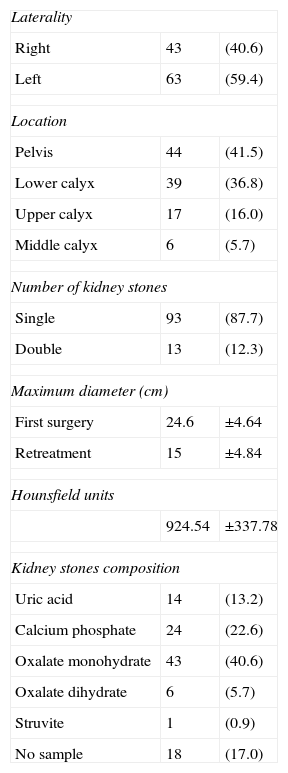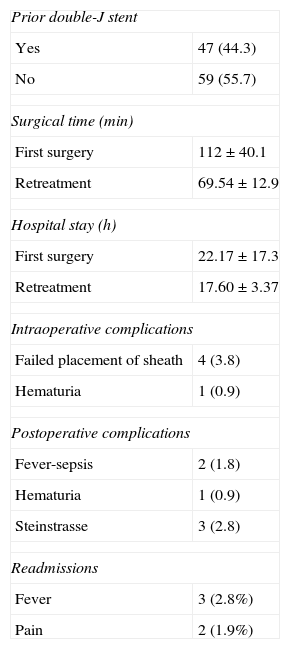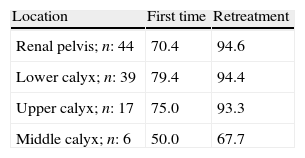To analyze the results of retrograde intrarenal surgery (RIRS) in patients with ≥2cm stones treated in our center.
Material and methodsA retrospective review of 106 patients with renal calculi underwent RIRS ≥2cm (period January 2009–December 2011). The procedures were performed under general anesthesia as a source of fragmentation using the holmium laser (30W Litho Quantasystem) and flexible ureteroscopes (X2 Flex Storz, Olympus P5) through ureteral access sheaths.
It discusses demographic variables (age, medical history, antiplatelet or anticoagulant treatment, treatment of urolithiasis, BMI, ASA), treated stones variables (size, number, Hounsfield units, biochemical composition) and intra- and postoperative variables (operative time, number of pulses, hospital stay, complications) with the completion of a descriptive analysis of the same.
To define our results we consider success to the complete absence of fragments or residual <5mm posterior imaging tests.
ResultsThe mean stone size was 2.46cm treated, being the only stone in 87.7% of cases. The most frequent location was the renal pelvis stones (44%) followed by the lower calyx (39%). The postoperative complication rate was 6.7%, with all of little relevance. The success rate with a single procedure was 79.4–94.1% with retreatment.
ConclusionRIRS is a valid alternative for the treatment of kidney stones ≥2cm for its high success rate and few complications if performed in specialized centers.
Analizar los resultados de la cirugía retrógrada intrarrenal (CRIR) en pacientes con litiasis ≥2cm tratados en nuestro centro.
Material y métodosRevisión retrospectiva de 106 pacientes con litiasis renales ≥2cm sometidos a RIRS (período comprendido entre enero de 2009 y diciembre de 2011). Los procedimientos se realizaron bajo anestesia general utilizando como fuente de fragmentación el láser Holmium (Litho 30W Quantasystem) y ureteroscopios flexibles (Storz Flex X2, Olympus P5) a través de vainas de acceso ureteral.
Se analizan variables demográficas (edad, antecedentes patológicos, tratamientos antiagregantes o anticoagulantes, tratamiento de litiasis, IMC, ASA), variables de litiasis tratada (tamaño, número, unidades Hounsfield, composición bioquímica) y variables intra y postoperatorias (tiempo quirúrgico, número de pulsos, estancia hospitalaria, complicaciones) con la realización de un análisis descriptivo de las mismas.
Para definir nuestros resultados consideramos éxito la ausencia completa de restos litiásicos o residuales <5mm en las pruebas de imagen posteriores.
ResultadosLa media de tamaño de las litiasis tratadas fue de 2,46cm, siendo la litiasis única en el 87,7% de los casos. La localización más frecuente de la litiasis fue la pelvis renal (44%) seguida del cáliz inferior (39%). La tasa de complicaciones postoperatoria fue del 6,7%, siendo todas de escasa relevancia. El porcentaje de éxito con un único procedimiento fue de un 79,4%, alcanzando el 94,1% con retratamiento.
ConclusiónLa CRIR es una alternativa válida para el tratamiento de litiasis renales ≥2cm por su alta tasa de éxito y escasas complicaciones si se realiza en centros especializados.










